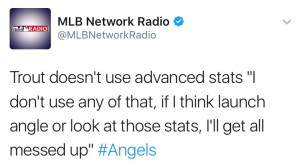Square peg, meet round hole.
We all know where this is going. It’s well known that we can’t force the square peg into the round hole, but we sure as hell try from time to time.
As a professional hitting coach that has been teaching the art of hitting the past 17 years, I certainly have tried to force the issue from time to time – especially early in my coaching days. But in recent years, I’ve seen a disturbing trend of the “online hitting coach” forcing their philosophies and ideals down young player’s throats, only to derail promising careers before they even start.
With technology readily at our fingertips, more and more hitters and coaches are crowded around computer screens and hand-held devices. This has led to the over-analyzation of the swing and overly-complicated terminology that is being fed to the younger generation of hitter.
I’ll give you an example of a scene that played out for a few years over and over when I was still giving lessons in the academy.
The player comes in for a session. He is looking for a new set of eyes and is frustrated with his results, or lack thereof, in the games. He’s been going to another hitting coach, otherwise known as the “guru,” for a few months who is all into the new gadgets, terminology and complicated data of the game. The guru has watched endless slow motion videos of Major League hitters – the majority of which, are grown men who are much stronger than people realize and whose bodies all work differently because of their massive stren gth. They take out their protractors, rulers and radar guns and measure launch angles and exit velos of a 12-year-old and try and compare him to the big leaguer on the screen. The guru has pointed out how the shin connects to the toenail, when the barrel has been turned, and when the elbow has slotted. The player has been working on strange drills that consist of twisting and contorting their bodies into pretzels in order to get the right launch angle or exit velocity. The guru has a 12-step process to the swing that would make a big leaguer’s mind fry, let alone a young, up and coming player. They are teaching movement patterns to try and match their swing perfectly to what they see on the screen, rather than teaching a thought process, feel or the intent needed to make it look like that.
gth. They take out their protractors, rulers and radar guns and measure launch angles and exit velos of a 12-year-old and try and compare him to the big leaguer on the screen. The guru has pointed out how the shin connects to the toenail, when the barrel has been turned, and when the elbow has slotted. The player has been working on strange drills that consist of twisting and contorting their bodies into pretzels in order to get the right launch angle or exit velocity. The guru has a 12-step process to the swing that would make a big leaguer’s mind fry, let alone a young, up and coming player. They are teaching movement patterns to try and match their swing perfectly to what they see on the screen, rather than teaching a thought process, feel or the intent needed to make it look like that.
The player is all excited to start using the online hitting guru’s famous swing equation and reap the benefits of their hard work, but alas they finished the season feeling further away from their dreams than ever before. The player swung through fastballs down the middle, the same pitch they were used to crushing just a season ago. The player had so much movement in their swing that they could barely recognize the pitch as it barreled toward them at the plate, causing them to chase balls out of the zone. They were working on fly balls in the cage, so when they did make contact they did exactly what they were working on – F-7, F-8, F-9. It was an emotionally draining season in which the player was the one who was hurt the most, while the coach went missing in action, free from consequence and accountability.
So now, it is my turn to have a conversation with this hitter and begin to help him put the broken pieces back together.
Hitting Is Simple. It’s Just Not That Easy.
I like to remind hitters that “Hitting is Simple. It’s just not that easy.” They constantly hear this from me. I love the simplicity it brings. I am very conscious of the words I use and my goal is to speak the player’s language, not mine. I spend a lot of “man hours” learning how the player thinks, what’s important to him and the “language” he speaks. Communication is key when you’re trying to relate material to a player. You must take very seriously the opportunity to keep things simple, while at the same time delivering actionable steps and principles. I go more in-depth on how I do this in my book The #GoodBatting Book which you can purchase here.
A long time ago, I learned that you couldn’t tell hitters how to hit or swing a bat. It was a lesson on the human element. Just like the old saying goes, the teacher only appears when the student is ready to learn. I see a lot of coaches who are charging hard with their information but fail to step back and ask themselves if the player is ready for the information or not.
Each player will hear your message through their own filters based on their perceptions and experience.
If coaches don’t understand this basic fundamental of teaching, they will never influence, impact and inspire as many players as they ultimately want to. Sometimes coaches think they are giving the player what he needs, but they fail to recognize that they need to give them what they want as well.
For example, the coach wants the player to hit more home runs. The hitter is a 6’5” “power hitter” and is a man amongst boys at his level. The coach thinks the player needs to hit more home runs in batting practice because he feels that will translate into the games. The player, on the other hand, knows himself really well and knows he needs to hit low line drives to CF in practice, so when game time comes, those low line drives turn into home runs.
Simply, there is a failure in communication because the coach didn’t take the time to ask the hitter how he prepares and WHY he takes batting practice the way he does. This leads to disconnect between the coach and the player, resulting in the player losing trust and respect for his leader. I’ll come back to this very important “teaching point” later in this post.
What Are You Selling?
Think about it this way. Coaches are always selling. In fact, every human transaction has a sale attached to it. Some may call it convincing or persuading, but I like to call it selling. Either way, there is a layer of persuasion that occurs to gain a result from an idea.
I am accused every once in awhile – OK maybe it’s more than once in awhile – of tricking hitters into thinking they can hit. I will neither confirm nor deny this since a magician never reveals his secrets, but my main objective is to help the hitter figure it out on their own.
Think about being a teenager. Some of you reading this are teenagers, and some of you are older, like me, and have already gone through that rebellious time in our life.
Let’s shine light on this classic example we have all encountered before, whether we were the teenager or the parent.
Parent: “Hey son, I don’t think it’s a good idea to swing at those curveballs in the dirt.”
Son: “Dad, what do you know? You never played in the big leagues!”
Parent: “True, but I’m just trying to help you and from what I’ve observed watching you, you’re much better hitting the fastball.”
Son: “Whatever.”
Now let’s insert a coach, or someone perhaps outside of the family circle, who the teenager respects and holds in high regard.
Coach/Mentor: “Hey man, why are you swinging at those curveballs in the dirt? Stay on the fastball. You hit those better.”
Teenager: “I know, I know. You’re right. I need to stop swinging at them. But how do I do that?”
Coach/Mentor: “What do you think you need to do?”
Most of you are either smiling, shaking your head, or both, after reading the exchanges. Most times when we laugh, it’s because something is true. And there is a lot of truth in the above narrative. But for the sake of the topic I’m discussing today, I want to focus on something important that transpired.
For starters, the information provided by the parent and the mentor are identical. It’s not the information that was bad from the parent. It was just that it came from the parent of a rebellious teenage boy.
Did you notice how the coach responded to the player after the player asked him how he should go about fixing his problem?
He said: “What do you think you need to do?”
This is key.
This showcases the power of the question and results in throwing the ball back into the player’s court so they can start taking ownership of their career. By asking that simple question, the coach is forcing the player to think. And when you start making the player think, he’s one step closer to finding the solution to his problem.
And the best part about it all? You didn’t tell him how. He figured it out on his own. You just asked really good questions and became the world’s best listener.
Love,
KW
For more than a decade, Kevin Wilson has been one of the most respected hitting coaches in the game. He works behind the scenes as a private hitting consultant to some of the best hitters in Major League Baseball. In 2013, Kevin was the hitting coach for the USA Baseball 18U National Team. Team USA beat Japan for the Gold medal at the IBAF World Cup in Taichung, Taiwan.
He is the author of the Amazon #1 Best Sellers The #GoodBatting Book and Finding Clarity: A Mindful Look Into the Art of Hitting and co-hosts a popular podcast, KWB Radio, that showcases unique conversations with the pros. If you want Kevin to speak at your next event or if you want take advantage of his popular 2-day KWB Experience for players and coaches, contact Kevin today!
Follow Kevin on twitter @KWBaseball and visit his website KWBaseball.com
